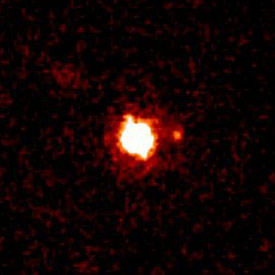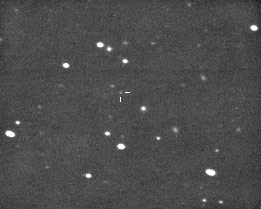
Michael Brown (Caltech) and his team discovered 2003 UB313's moon (dot at right) in a series of adaptive-optics images shot at Keck Observatory in Hawaii. It moved in parallel with the main object during the course of a night, ruling out the chance that it is a background star or an unrelated asteroid.
Courtesy W.M. Keck Observatory.
The solar system's largest known Kuiper Belt object (KBO), the recently discovered body known as 2003 UB313, isn't wandering through space alone.
Michael E. Brown (Caltech) and his colleagues have discovered that it has a small companion, by using the newly commissioned Laser Guide Star Adaptive Optics system on the Keck II telescope atop Mauna Kea, Hawaii, on September 10th. The team doesn't yet know the moon's orbit, since they have only a single night of images. But observations with the Hubble Space Telescope planned for November and December should help determine the moon's orbital period and distance from 2003 UB313, and thus that object's mass. Due to scheduling constraints the team can't observe the system with Keck again for several months. Still, Brown says, "by January we should know the orbit."
The satellite is about 100 times (5 magnitudes) fainter than 19th-magnitude 2003 UB313. So if its surface has about the same reflectivity, its diameter is about a tenth that of the main body. That would make the satellite about 270 kilometers across.
Having a moon may not help 2003 UB313 gain official status as a "planet," but certainly it can't hurt. Right now an International Astronomical Union (IAU) committee is deciding whether 2003 UB313 should be officially classified as the tenth planet in the solar system. In the meanwhile, recent new observations with the infrared Spitzer Space Telescope have allowed Brown and his team to confirm that the object is indeed larger than the previous KBO record holder, Pluto, by about 20 percent. Their current value for its diameter is 2,700 km, compared to Pluto's 2,274 km. The size measurement will be finalized in the coming weeks, but "if it's not larger than Pluto, then I'll eat my telescope," says Brown.
The team will submit its discovery paper tomorrow to Astrophysical Journal Letters. The public announcement of the satellite was scheduled for the same time, but a media leak prompted the team to go public early.

Advanced amateurs have been imaging the 'tenth planet' too — though certainly not its moon. Just hours after the existence on 2003 UB313 was announced, Gianluca Masi and Roger Wilcox imaged it (the faint object at center marked by white ticks). Masi writes, 'This 5-minute CCD image was grabbed remotely using the 36-centimeter [14-inch] SoTIE Telescope in Las Campanas, Chile. North is up, east is left. The field of view is about 8.5 by 7 arcminutes.' They also made a blink movie of the object showing its motion on the sky in 4 hours.
Image by Gianluca Masi.
Once the IAU rules on the status of 2003 UB313 — as a "planet" or a mere "trans-Neptunian object" — another committee will decide on names for the object and its moon. For now, Brown's team has been calling them by the nicknames Xena and Gabrielle, after the partners from the TV show Xena: Warrior Princess.
The pair are currently 97 astronomicial units from the Sun, more than twice the average distance of Pluto. They're the farthest object ever seen in the solar system.
The discovery of "Gabrielle" raises new questions about the nature of the bodies in the asteroid-belt-like region beyond the orbit of Neptune. With the new find, three of the four largest known Kuiper Belt objects (including Pluto) have satellites. However, the vast majority of small KBOs travel solo. Astronomers aren't sure why this discrepancy exists, but it may suggest that small binary bodies fell into orbit around each other by gravitational capture (involving a third body that carried away energy and momentum), while large KBOs gained their moons from the debris following giant collisions, the same way the early Earth got its moon. Future research into the new binary pair should help resolve this and other Kuiper Belt mysteries.
 0
0
Comments
You must be logged in to post a comment.